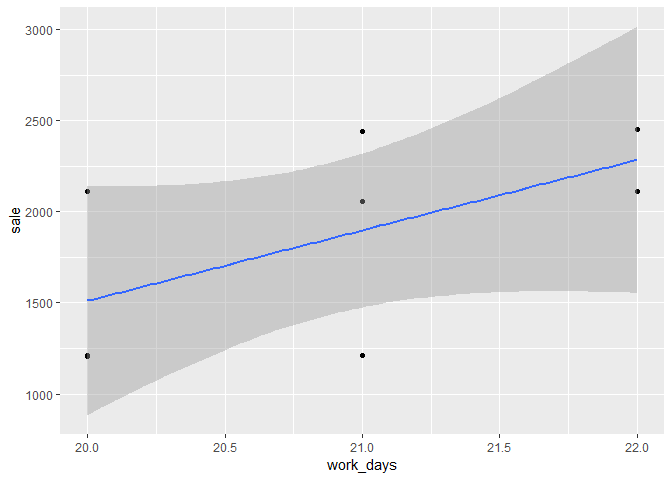We are trying to understand the impact of number of workdays on sales.
Please find reprex below:
library(tidyverse)
# Work days for January from 2010 - 2018
data = data.frame(work_days = c(20,21,22,20,20,22,21,21),
sale = c(1205,2111,2452,2054,2440,1212,1211,2111))
# Apply linear regression
model = lm(sale ~ work_days, data)
summary(model)
Call:
lm(formula = sale ~ work_days, data = data)
Residuals:
Min 1Q Median 3Q Max
-677.8 -604.5 218.7 339.0 645.3
Coefficients:
Estimate Std. Error t value Pr(>|t|)
(Intercept) 2643.82 5614.16 0.471 0.654
work_days -38.05 268.75 -0.142 0.892
Residual standard error: 593.4 on 6 degrees of freedom
Multiple R-squared: 0.00333, Adjusted R-squared: -0.1628
F-statistic: 0.02005 on 1 and 6 DF, p-value: 0.892
Could you please help me understand if the coefficients
Every work day decreases the sale by 38.05 ?
##############################################
data = data.frame(work_days = c(20,21,22,20,20,22,21,21),
sale = c(1212,1211,2111,1205,2111,2452,2054,2440))
model = lm(sale ~ work_days, data)
summary(model)
Call:
lm(formula = sale ~ work_days, data = data)
Residuals:
Min 1Q Median 3Q Max
-686.8 -301.0 -8.6 261.3 599.7
Coefficients:
Estimate Std. Error t value Pr(>|t|)
(Intercept) -6220.0 4555.9 -1.365 0.221
work_days 386.6 218.1 1.772 0.127
Residual standard error: 481.5 on 6 degrees of freedom
Multiple R-squared: 0.3437, Adjusted R-squared: 0.2343
F-statistic: 3.142 on 1 and 6 DF, p-value: 0.1267
Does this mean,
Every workday increases the sales by 387 ?
How about the negative intercept ?

